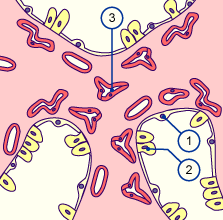|

|
|
|
18.1 Phases of lung development
|
|
|
|
In the classical description of lung development, in this phase the canaliculi branch out of the terminal bronchioli. The canaliculi compose the proper respiratory part of the lungs, the pulmonary parenchyma. All of the air spaces that derive from a terminal bronchiolus form an acinus. Each one comprises respiratory bronchioli and the alveolar ducts and later the alveolar sacculi. The chief characteristic of this canalicular phase is the alteration of the epithelium and the surrounding mesenchyma. Along the acinus, which develops from the terminal bronchiolus, an invasion of capillaries into the mesenchyma occurs. The capillaries surround the acini and thus form the foundation for the later exchange of gases. The lumen of the tubules becomes wider and a part of the epithelial cells get to be flatter. From the cubic type II pneumocytes develop the flattened type I pneumocytes.
|
|
|
| A sufficient differentiation of the type II pneumocytes into the type I pneumocytes and the proliferation of the capillaries into the mesenchyma marks an important step towards the fetus being able to survive outside the uterus after roughly the 24th week of pregnancy. |
|
Fig. 6 - Lung tissue in the canalicular phase |
|
Legend |
|

1
2
3
|
Type I pneumocytes
Type II pneumocytes
Capillaries |
|
|
|
Fig. 6
The type I pneumocytes differentiate out of the type II pneumocytes. The capillaries approach the walls of the acini.
|
|
More info
|
|
The first breathing movement can be registered already at the end of the embryonic period. They are controlled by a breathing center in the brain stem. Nevertheless, these breathing movements are paradoxical in that when the diaphragm contracts, the thorax moves inwardly and vice versa. (2)
|
|
|
|
|
|
At the end of this canalicular phase which is the beginning of the saccular phase (ca. 25 weeks) - a large part of the amniotic fluid is produced by the lung epithelium. From this time on, the maturity of the lungs can be measured clinically based on the activity of the type II pneumocytes, which begin to produce the surfactant. The ratio of lecithin to sphingomyelin in the amniotic fluid, which increases with fetal age is determined. I
In this stage developmental damage already affects the gas-exchange components and result in structural alterations of the later pulmonary parenchyma.
|
|
|
|
More info
|
|
The surfactant (abbreviation for surface active agent) consists of glycerophospholipids, specific proteins, neutral fats and cholesterol. It covers the alveolar surface and reduces the surface tension so that, following birth, the alveoli do not collapse during the expiration.
|
|
|
|
|
|
|

